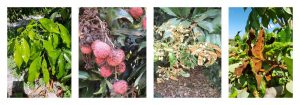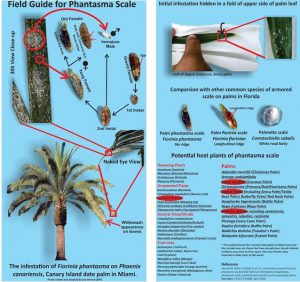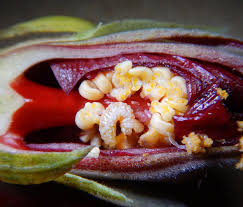What do the following names have in common: Anthonomus testaceosquamosus, the hibiscus bud weevil; Fiorinia phantasma, the Phantasma Scale; Aceria litchii, the lychee erinose mite? All these pests were introduce or reintroduce to Florida during 2018 and were either new state or US record.
Aceria litchii, the lychee erinose mite
The lychee erinose mite has been found at two different locations in Lee County, Cape Coral (January, 2018) and Pine Island (February, 2018). The mite causes abnormal growths, curling and galls on leaves, which later become reddish-brown in appearance. This damage can initially appear superficial, but as the numbers of the mite increase, damage spreads to the fruits and flowers (Fig. 1). The mites only affect lychee (Litchi chinensis) and are too small to be observe directly without a microscope, so you need to rely on the plant symptoms.

Fiorinia phantasma, the Phantasma Scale
It’s an armored scale affecting mainly the underside of the fronds located in the lower part of the canopy. The first U.S. continental record was collected in a Phoenix canariensis, Canary Island date palm on March from a non-commercial setting in Miami-Dade County. In other countries it has been found infesting at least 24 families of plants with marked preference for Arecaceae (palm trees) (Fig.2). Biological control is very important to keep the scale under control.

Anthonomus testaceosquamosus, the hibiscus bud weevil
During 2018, samples from the weevil were collected and identified positive in Broward, Miami-Dade and Hernando counties. This weevil is reported to feed on malvaceous flower buds, which potentially could cause significant loss of hibiscus flower buds. Adults lay eggs on young flower buds, and the immature weevils feed on the developing pollen (Fig. 3)

For more information, check FDACS website at https://www.freshfromflorida.com/Divisions-Offices/Plant-Industry/Plant-Industry-Publications/Pest-Alerts
 0
0
